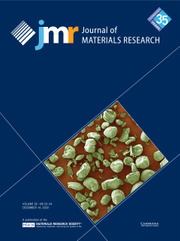Article contents
Diamond nucleation on nickel substrates seeded with non-diamond carbon
Published online by Cambridge University Press: 03 March 2011
Abstract
Oriented diamond films have been nucleated on single crystal nickel substrates seeded with non-diamond carbon and annealed at high temperatures in atomic hydrogen. The non-diamond carbon seeds included graphite powders, fullerene (60) powders, and gaseous carbon species. It was found that these different non-diamond carbon powders or species were effective in the enhancement of oriented nucleation of diamond. The morphologies of diamond films were similar regardless of the types of carbon used, suggesting a common nucleation mechanism involved. Based on the experimental observations, a revised model was developed for the oriented nucleation of diamond on Ni.
Information
- Type
- Rapid Communications
- Information
- Copyright
- Copyright © Materials Research Society 1994
References
REFERENCES
1Rudder, R. A., Posthill, J. B., Hudson, G. C., Mantini, M. J., and Markunas, R. J., Proc. SPIE on Diamond Optics 969, 72 (1988).CrossRefGoogle Scholar
3Badzian, A. R. and Badzian, T., in Chemical Vapor Deposition of Refractory Metals and Ceramics II, edited by Besmann, T. M., Gallois, B. M., and Warren, J. (Mater. Res. Soc. Symp. Proc. 250, Pittsburgh, PA, 1992), p. 339.Google Scholar
4Sato, Y., Yashima, I., Fujita, H., Ando, T., and Kamo, M., in New Diamond Science and Technology, edited by Messier, R., Glass, J. T., Butler, J. E., and Roy, R. (Mater. Res. Soc. Symp. Int. Proc. NDST–2, Pittsburgh, PA, 1991), p. 371.Google Scholar
5Fujita, H., Ando, T., Kamo, M., Tanaka, T., and Sato, Y., in Proc. of the 1991 Spring Jpn. Appl. Phys. Meeting, edited by Jpn. Phys. Soc. (Tokyo, Japan, 1991), p. 13.Google Scholar
7Zhu, W., Yang, P. C., and Glass, J. T., Appl. Phys. Lett. 63 (12), 1640 (1993).CrossRefGoogle Scholar
8Yang, P. C., Zhu, W., and Glass, J. T., in Proceedings of the 3rd Int. Symp. on Diamond Material, edited by Dismukes, J. P., Ravi, K. V., Spear, K. E., Lux, B., and Setaka, N. (The Electrochemical Society, Pennington, NJ, 1993), p. 435.Google Scholar
11Johnson, A. D., Daley, S. P., Utz, A. L., and Ceyer, S. T., Science 257, 223 (1992).CrossRefGoogle Scholar
- 26
- Cited by

